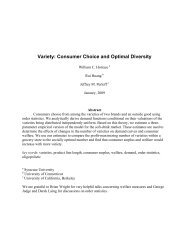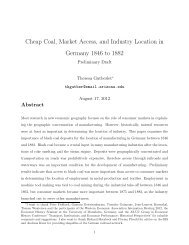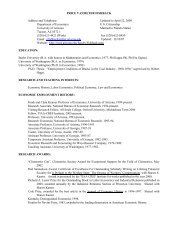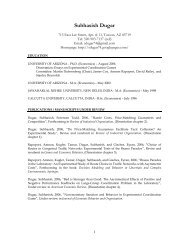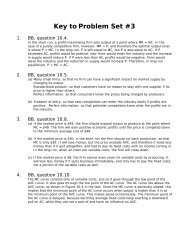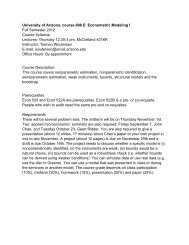A Dynamic Model of Demand for Houses and Neighborhoods
A Dynamic Model of Demand for Houses and Neighborhoods
A Dynamic Model of Demand for Houses and Neighborhoods
Create successful ePaper yourself
Turn your PDF publications into a flip-book with our unique Google optimized e-Paper software.
Figure 4: Violent Crimes (per 100,000 residents)<br />
two channels: wealth accumulation, <strong>and</strong> moving costs. Households have expectations about<br />
appreciation <strong>of</strong> housing prices <strong>and</strong> may rationally choose a neighborhood that <strong>of</strong>fers lower current<br />
period utility in return <strong>for</strong> the increase in wealth that would accompany price increases in that<br />
neighborhood. The other component <strong>of</strong> the neighborhood choice problem that induces <strong>for</strong>ward<br />
looking behavior on the part <strong>of</strong> households are moving costs. Because households typically pay<br />
5-6 percent <strong>of</strong> the value <strong>of</strong> their house in real estate agent fees in addition to the non-financial<br />
costs <strong>of</strong> moving, it is prohibitively costly to re-optimize every period. As a result, households<br />
will naturally consider expectations <strong>of</strong> the future utility streams when deciding where to live.<br />
There<strong>for</strong>e, households likely make trade-<strong>of</strong>fs between current <strong>and</strong> future neighborhood attributes,<br />
choosing neighborhoods based in part on demographic or economic trends.<br />
We model households as making a sequence <strong>of</strong> location decisions that maximize the dis-<br />
counted sum <strong>of</strong> expected per-period utilities. Our general model can be <strong>for</strong>mulated in a familiar<br />
dynamic programming setup, where a Bellman equation illustrates the determinants <strong>of</strong> the op-<br />
timal choice. We model households as choosing between neighborhoods. As discussed in the<br />
data section, each neighborhood has approximately 10,000 houses <strong>and</strong> is created by combining<br />
U.S. Census tracts. Our data <strong>for</strong> the San Francisco Bay Area includes in<strong>for</strong>mation on over<br />
one million house sales in 225 neighborhoods between 1990 <strong>and</strong> 2004. In each period, every<br />
14



